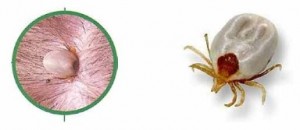Tick Prevention For Dogs, NSW
By John Morgan | Dated May 4, 2015
What are Paralysis Ticks?
Paralysis ticks are nasty parasites that can be fatal to dogs and cats in Australia. They are common in coastal areas mostly during spring and summer, however paralysis ticks can be found all year round. Possums and bandicoots are the natural hosts of the paralysis tick, meaning that the tick lives on them quite happily without making them sick.

Paralysis Tick
Ticks attach to our pets as they walk through grass or bushland where native fauna such as possums and bandicoots have been. Most pets are affected without even leaving their backyard!
How do paralysis ticks make my pet sick?
Adult paralysis ticks have a pear to oval shaped body and are usually light grey in colour. They attach to the skin of the dog or cat and feed on their blood. While feeding, the tick secretes a toxin (poison) from its mouthparts which effects the animal’s nervous system. When ticks first attach they are small but they increase in size over about a week as they become engorged with blood.
What are the symptoms of paralysis tick poisoning?
Wobbly gait, especially hind legs
- Muted barking
- Rapid, noisy breathing
- Slow, grunting breathing
- Coughing, gagging, drooling & vomiting
- Less apparent signs include lethargy & loss of appetite
Once signs of paralysis tick poisoning appear, dogs and cats can become ill very quickly. If your pet is showing any symptoms, it is important they are seen by a vet immediately. The earlier the tick treatment for dogs, the better their chance of survival. If left untreated they will die. The vet administers tick anti-serum which prevents any further poisoning from the toxin. Hospitalisation and other treatment may be required for several days.
How should I protect my pet from ticks?
Preventing tick paralysis is a much safer and cheaper alternative to treating the condition once it has occurred.
1. Search pets every day for ticks
The most important tick prevention is a thorough search of your pet’s skin and coat every day during the paralysis tick season. This should be done even if tick control products have been given. It is best to feel for ticks with the tips of your finger. Adult ticks are often at least 3mm in diameter. Start in the common places such as the head and neck, but search everywhere.

Search pets every day for ticks
2. Tick prevention products
In addition to daily searching, regular administration of tick control products greatly reduces the risk of tick poisoning. Be aware that tick treatment and control products indicated for dogs only are NOT suitable for use in cats.
- Advantix – A liquid ampoule applied every two weeks to the back of the neck in dogs
- Kiltix or Scalibor collar – Can be used in combination with Advantix and repels ticks
- Frontline Top Spot – An alternative to Advantix. It is a liquid ampoule applied every two weeks to the back of the neck in dogs
- Frontline Spray – A spray applied every 3 weeks over the body of dogs and cats. (Use gloves and rub into skin and coat)
- Nexgard – A new product that is a once a month chewable tablet for dogs
- Bravecto – A new product that is a chewable tablet for dogs given every 3 months
3. Removing ticks on your pet
The best way to remove a tick is with a special hook designed for removing them. Alternatively tweezers are quite effective. Grip the tick as close as possible to its mouthparts (where it meets the skin) to avoid leaving these in. There is no benefit to killing the tick first or applying irritant substances such as alcohol to it. If in doubt, it is always best to call your vet for advice.



